Translate this page into:
Intraoperative instrument breakage during the orthopedic elective procedures: A retrospective single-center experience
Address for correspondence: Dr. Ganesh Singh Dharmshaktu, Department of Orthopaedics, Government Medical College, Haldwani - 263 139, Uttarakhand, India. E-mail: drganeshortho@gmail.com
-
Received: ,
Accepted: ,
This article was originally published by Wolters Kluwer - Medknow and was migrated to Scientific Scholar after the change of Publisher.
How to cite this article: Dharmshaktu GS, Adhikari N, Mourya P, Bhandari SS, Singh P. Intraoperative instrument breakage during the orthopedic elective procedures: A retrospective single-center experience. J Orthop Spine 2020;8:80-5.
Abstract
BACKGROUND:
Fracture fixation accounts for majority of orthopedic surgical interventions with most procedures requiring variety of instruments as part of surgical armamentarium. Breakage of instruments during the operation is unwanted experience and may complicate or lengthen the procedure thus interfering with overall outcome. A study regarding the pattern of intraoperative instrument failures is thus important to gain fruitful insights for not only preventive strategies but for further studies in this context.
MATERIALS AND METHODS:
A retrospective study of all consecutive incidents of instrument breakage during a 2-year period (January 2017 to December 2019) were recorded with relevant details such as type of surgery, type of implant, type of instrument and the probable cause, management and key demographic details during 2-year period at a tertiary care center in North India. Knowledge about the risk factors was tried to be extracted from our observations.
RESULTS:
Out of a total 8132 elective major and minor cases during the study period, 30 (0.36%) cases of intraoperative instrument breakage were noted. The types of instrument broken in the descending order with numbers in the bracket were drill bits (5), guidewires (3), manual intramedullary reamers (3), periosteal elevator (3), screwdriver tip, and bone tap in two cases each. The power-driven flexible reamer, screwdriver tip, screwdriver handle, proximal jig for the intramedullary nail, bone nibbler, and bone lever were another instruments with singular incidents. In the general instruments, long artery forceps (4) was the most common to break followed by mosquito forceps (3) and one nose-plier in separate cases.
Conclusion:
The breakage of surgical and non-implant instruments during the operation is uncommon event but requires proper documentation and due acknowledgement for prohibitive and management guidelines.
Keywords
Broken instrument
fixation
fracture surgery
instrument break
intraoperative complication
metal instruments
metallic failure
surgical instruments
Introduction
Various instruments are the part of fracture fixation surgeries as assistive devices in surgical procedures. Most of these instruments are metallic while some are nonmetallic or a mix of both. Mechanical advantage and ease of surgery gained from their usage is important for rapid and uneventful surgery. Surgical instruments are mostly metallic, sturdier, and make fracture surgeries easier but are not immune to failure. There are various complications reported associated with implants in the peri-operative period or in the follow-up including their breakage. Instruments breakage is believed to be less commonly reported than their actual incidents. A reported incident of 0.35% is noted in one recent multi-centric study of more than eleven thousand procedures.[1] Most of broken pieces were left and caused no clinical problems. Many of these incidents are caused by poor-quality instruments and carry a public safety concerns, thereby the formation of an agency to report and manage similar cases is advocated.[2] Gathering data regarding common instrument breakage during the operation is the initial step in the understanding of the prevalence and pattern of these problems as these incidents are still largely an under-reported and underappreciated issue.
Materials and Methods
Relevant single-center data regarding all retrospective cases of instrument intra-operative breakage were noted for a period of 2 years from January 2017 to December 2019 in a tertiary care hospital of North India. The data of only elective surgery cases were maintained with relevant details such as type of fracture, extremity involved, bone involved, and type of fracture and surgery. The type of implant and instrument were noted separately for each case. Few other key details noted were the number of operative washed personnel, whether emergency or elective surgery, approach and position of the patient, use of fracture table or special postures. The type of broken instrument, the probable reason, further management, and postsurgery analysis of broken instruments were also noted for each case. The exclusion criteria were implant related complications in the emergency surgery. Other exclusions were any implant (which are not instruments) related complications, including intra-operative breakage, breakage of already compromised appliances or failure of appliances used as implant in fracture fixation or any object other than one used in surgery. Instruments failed before or after any surgery were also excluded. The data were recorded in Microsoft Excel sheets for an easy tabulation.
Results
A total of 8132 (6517 major and 1615 minor procedures) elective major and minor cases were part of the study for the 2-year duration of study period. A total of 30 (0.36%) cases of intra-operative instrument breakage were noted in our study. The instrument that found broken were drill bits in five cases [Figure 1a], guide wires for proximal femur surgery in 3 cases, manual reamers for interlocking nails in three cases [Figure 1b]. Three cases of periosteal elevator [Figure 2a] and 2 each of screwdriver tip [Figure 2b] and bone tap [Figure 2c] were also found. The other singular reports of instrument breakage included flexible intra-medullary reamer, screwdriver handle, bone nibbler [Figure 3a], bone lever [Figure 3b], and proximal jig for interlocking nail. The general surgical instruments broken were long artery forceps and mosquito forceps in 4 and 3 cases, respectively [Figure 4a]. One case of nose-plier breakage was also noted [Figure 4b]. The tabulated description of these instruments is given in a table form [Table 1]. Most common operations related with implant failure were that of lower limb. Hip surgeries were related to all broken guidewire failures – Two cases were part of during dynamic hip screw (DHS) fixation and one each of cannulated cancellous screw fixation for fracture neck femur and proximal femur nail (PFN) for intertrochanteric fracture. Broken guidewires removal was done under image guidance and was successful in three cases while the broken part was left in situ in 1 case. Drill bits were also associated with hip fracture surgeries in 4 cases and distal femur surgery in 1 case. All drill bit pieces were successfully removed as they were visible within surgical field. In one case, the breakage was identified by nursing staff in the immediate postoperative period followed by prompt removal. Manual reamers broke during interlocking nail procedure for femur and tibia in 2 and 1 cases, respectively, while one case of femur nailing had flexible reamer breakage. Broken reamers were easily removed due to presence of ball tipped guidewire. Bone tap failure was noted in two case of forearm bone fracture plating and did not pose problem in easy removal under direct vision. Screwdriver tip failure was unusual event, and tip was found broken within adjacent soft tissues, careful extension of dissection required for removal, and the part of tip in another case was found buried within screw head. Gentle taping with metallic object loosened the broken part which then separated easily from screw head. Periosteal elevator and nibbler were broken while fixing neglected femur case that required prolonged surgery and dissection. The prolonged use of the same instruments for years might have added to their failure. Bone lever tip was broken in an old locking compression plate removal from tibia and required prolonged surgery and extra dissection under image intensifier for successful removal. Nose-plier was broken during old square nail removal attempt before final extraction with another plier. Proximal jig of interlocking nail failure following the mounting of nail to it and immediately after initial introduction into the canal was a rare complication [Figure 5]. It halted the surgery till other jig was arranged and surgery completed. Propagation of previous fatigue failure or cracks might be reason behind it. General surgery instruments were broken in many cases and mainly were artery forceps that are widely used during the surgery. Their breakage was mainly due to technical issues in all like their use for tasks other than their indications such as holding intramedullary guide wire with them, bending wires with them or attempting removal of wires or screws with them. These instruments were noted in the discard register of worn out and nonfunctional instruments.
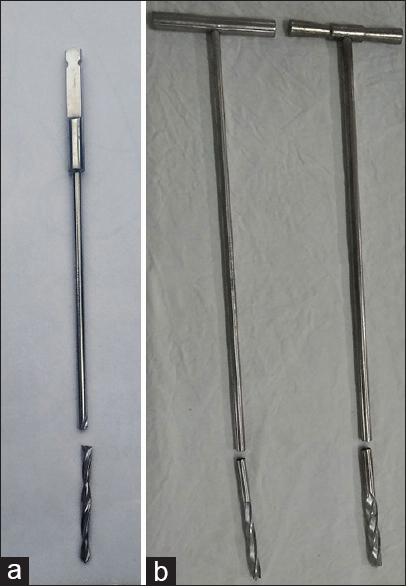
- The broken drill bit through proximal threads (a) and two manual intra-medullary reamers broken above the cutting thread region (b)
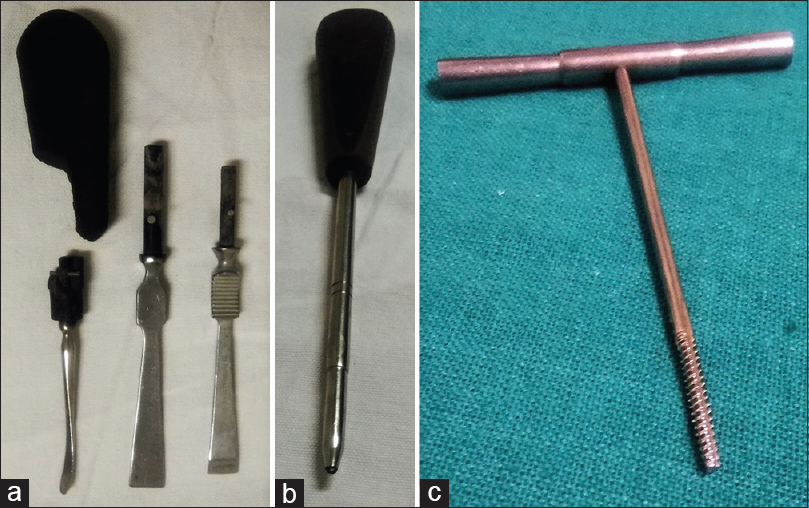
- The periosteal elevators with wooden handle broken and its metallic part separated (a), the screw-driver with broken tip (b). The bone tap broken through its thread part (c)
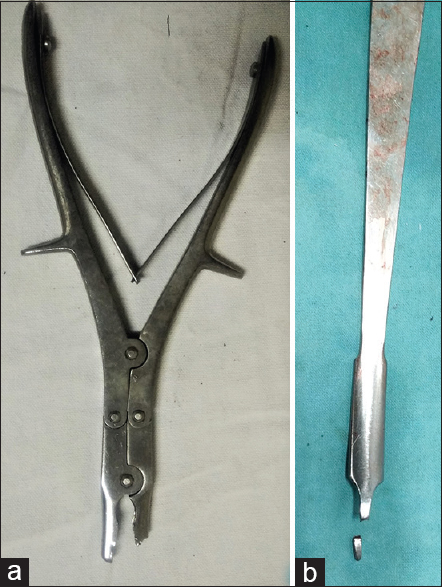
- The broken tip of the bone nibbler (a) and the bone lever (b)
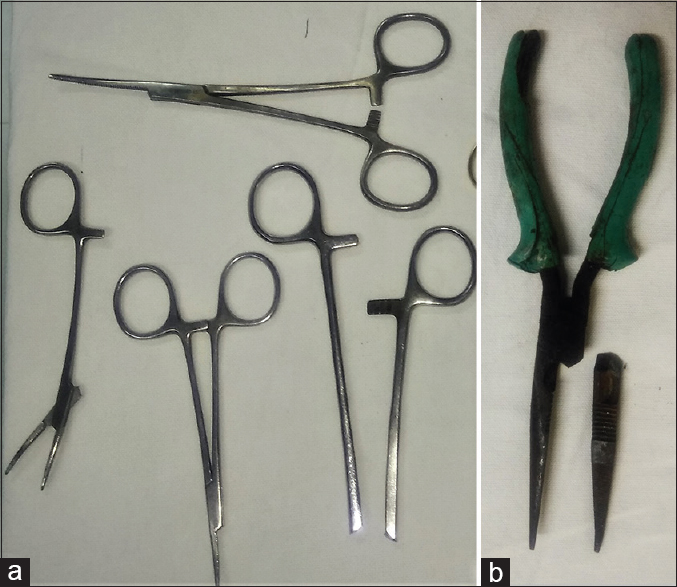
- Some broken artery forceps (a) and a nose plier with one broken prong (b)
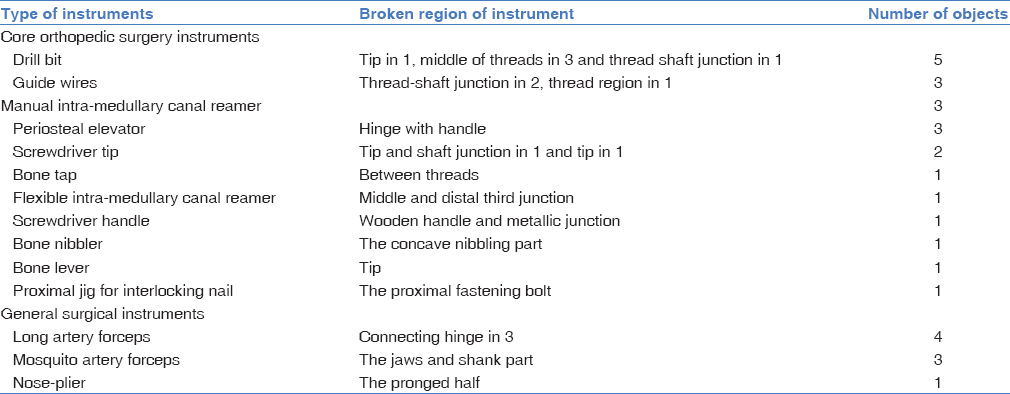
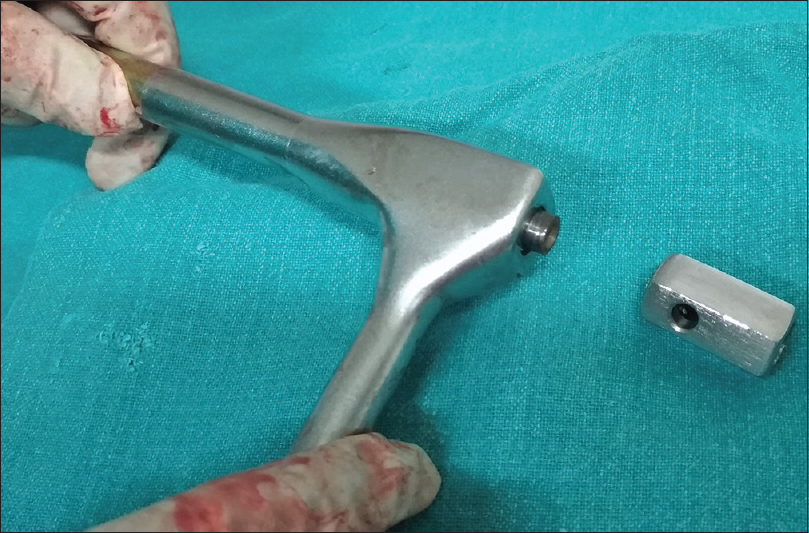
- The part of proximal jig for femoral nail broken soon after mounting the nail. The another jig arrangement delayed the surgery
Discussion
Very few studies or anecdotal reports describe instrument failure which is not enough to know about these critical complications. Only 14 cases of instrument failure, most of them being drill bits, were reported in a 2-year study of more than seven thousand procedures. Initial years of surgeons are found to be associated with most breakage.[3] Many a times, the broken instruments can be seen under vision and are retrievable without difficulty. There are several methods for the removal of difficult drill bits.[4] There is always possibility of not able to remove the drill bit and had to be left for later or no removal at all on basis of potential future problems.[5] In our series, fortunately, all drill bits were easily removed as they were broken with the broken piece still visible. Guide pins are other common breaking instrument and may break if it is the first instrument to contact and penetrate the bone. As these are thinner than the implant and are flexible in most instances, working through the hard bone has inherent chance for their breakage. Besides it, their repeated use and resultant deformation and deflection may potentiate its erosion resulting in breakage.[6] Innovative techniques have been described to retrieve these wires with anecdotal reports.[7,8] Removal of the already introduced implant might be required in some difficult cases for the removal of broken guidewire. Judicious use of various other instruments such as cannulated drill bits, Kerrison rongeur, and pituitary forceps can be done for their successful removal. In a more serious case, broken part may migrate into distant anatomical territory like pelvis during hip surgery and may require another surgical approach for its removal.[9] Migration of broken drill bits is another future complication that may present itself years after the event. The removal of migrated bit depends on the location and probable ease of the procedure at surgeon's discretion. The usual indication of removal may be loose lying broken part in tissue or joint, or close to the neuro-vascular structures.[10]
Drill bit can also break once hitting with another metallic instrument such as femoral distractor pins in cases with distal femur fracture surgery. The engagement of broken bit within the medullary cavity is uncommon but potential complication. One report of this complication and removal of bit with pituitary rongeur has been reported.[11] In a series of three cases of broken guide pin removal following DHS fixation in intertrocahnteric fractures, pins was removed with the help of 2 mm cannulated drill bit under fluoroscopy. The author stated that as the shape of pins changes to oval rather than a round shape at the point of break, these are engaged by a cannulated drill bit allowing their removal.[12] Retrieval of threaded guide pin is problematic issue. Another report of a broken guidewire during subtrochantrer fracture fixation by PFN led to transfixation of hip joint. Manually controlled drilling with cannulated drill bit over T-handle was done at the base of guidewire to make space followed by the removal with Kerryson rongeur/grasper.[13] The above method may be helpful in low-resource settings, whereas in advanced centers, endoscopic-assisted retrieval of the broken piece can be attempted successfully.[14] Another good technique of removal with benefit of no extra instrumentation or incision, but limited to bits longer than the diameter of bone, is described as “push back” technique. In this technique, the backward force provided by a right-angled retractor on medial aspect of femur over the penetrating bit part leads to the broken part sliding the tract and appearing more from the lateral entry site which now can easily be removed under direct vision.[15] The authors advocate proper documentation and explanation to patient, relatives, and concerned implant company regarding these incidents.[16]
Reamers for nailing are other uncommon instruments to break. Both flexible and rigid reamers have been reported to break. The beaded guidewire helps in the removal of most broken parts, but things are complicated in overzealous manual rigid reamer usage or when beaded guidewire is not used. Various reports of innovative techniques are described through case reports.[17,18] Sometimes cephalo-medullary reamer for lag screw insertion for PFN is broken, but we had no such incidents.[19] Incarcerated reamer inside medullary canal pose great surgical challenge and may require a bone window creation. One case of flexible reamer breakage during proximal femoral nail anti-rotation has also been reported.[20] Reaming in a smooth tipped or non-olivary guide wire during nailing is the risk factor for difficult removal and more so if reamer is broken in distal fracture fragment.[21] We used ball-tipped guidewires in most cases to bail us out of most such complications. Screwdriver tip breaking is rare incident and potential complication as screws or bolts are widely used in orthopedic surgeries. The breakage of screwdriver is, however, not widely reported in the literature. One similar case during nailing was detected when screw did not seemed to be tightening despite efforts only to reveal broken tip that was later removed under fluoroscopy guidance.[22] Proximal jig failure has also been reported only once but that was noted when the nail was introduced and locked followed by an innovative approach for its removal.[23] Our case was identified before nail insertion and so did not require removal efforts. The incidents of instrument breakage may prolong surgery time and add to the complication by additional procedures such as extra incision, making fenestration in the bone to remove broken instruments in a destructive and unwanted process.[24] The lessons can be drawn from anecdotal reports and incidents for anticipation of these events. Remedial tips and guidelines should be remembered and difficult cases and innovative methods should be shared. We have also attempted to draft a few practical tips to avoid these complications based on the study and cumulative experience [Table 2]. The shortcomings of the present study, however, was the exclusion of emergency cases as emergency surgeries have potential for more errors with regards to implant or instrument handling and also owing to the fact that less experienced colleagues or students are more involved. Overall, instrument breakage are uncommon but potential complication in orthopedic and trauma surgeries and may lead to various complications such as increased operative time and its sequelae apart from additional trauma to muscles and bone in certain cases. Careful approach and guidelines have to be formulated by orthopedic associations and standard operating principles be formulated in this context.
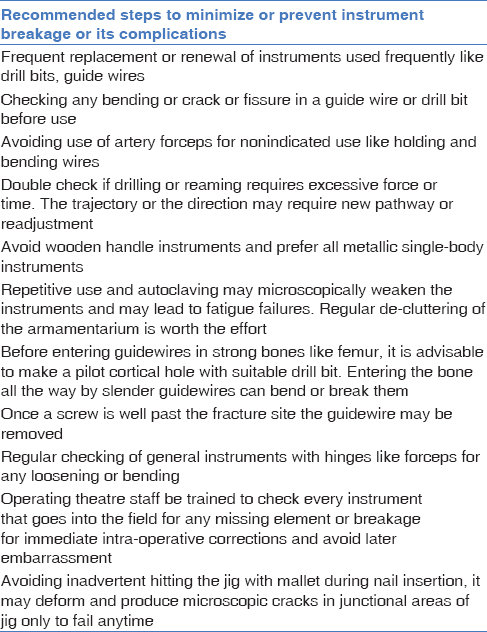
Conclusion
The knowledge of type and pattern of intra-operative instrument breakage is an important element of surgical trauma management. Care should be exercised to avoid these untoward accidents and bail-out strategies should be planned for individual pattern. Large data or registry formation may be another step to gain more insights in this context in the future.
Financial support and sponsorship
Nil.
Conflicts of interest
There are no conflicts of interest.
References
- Frequency of instrument breakage during orthopaedic procedures and its effects on patients. J Bone Joint Surg Am. 2008;90:2652-4.
- [CrossRef] [PubMed] [Google Scholar]
- Patient safety incidents caused by poor quality surgical instruments. Cureus. 2019;11:e4877.
- [CrossRef] [Google Scholar]
- The rate of instrument breakage during orthopaedic procedures. Int Orthop. 2002;26:185-7.
- [CrossRef] [PubMed] [Google Scholar]
- A technique for removal of broken canulated drill bit: Bassi's method. J Orthop Trauma. 2008;22:56-8.
- [CrossRef] [PubMed] [Google Scholar]
- Drill bit failure without implant involvement--an intraoperative complication in orthopaedic surgery. Injury (23 Suppl 2):S5-16.
- [CrossRef] [PubMed] [Google Scholar]
- A technique to remove a broken guide wire transfixing the hip joint. Acta Orthop Belg. 2008;74:683-5.
- [Google Scholar]
- Broken kirschner or guide-wire retrieval: A report of 4 cases. Hip Int. 2010;20:551-4.
- [CrossRef] [PubMed] [Google Scholar]
- A useful surgical technique for removal of a broken guide pin in the midfoot. J Foot Ankle Surg. 2014;53:120-3.
- [CrossRef] [PubMed] [Google Scholar]
- Intrapelvic protrusion of a broken guide wire fragment during fixation of a femoral neck fracture. Arch Bone Jt Surg. 2017;5:63-5.
- [Google Scholar]
- Migration of a broken drill bit after acetabular fracture fixation: A case report. Malays Orthop J. 2011;5:56-9.
- [CrossRef] [Google Scholar]
- A novel method of removal of a broken drill bit in the femoral medullary canal during internal fixation of a type C distal femoral fracture: A case report. Chin J Traumatol. 2012;15:315-6.
- [Google Scholar]
- New method to remove a broken guide pin in the hip joint. Orthopedics. 2011;34:e685-7.
- [CrossRef] [Google Scholar]
- A simple technique to retrieve broken guide wire transfixing hip joint. J Orthop Allied Sci. 2015;3:31-2.
- [CrossRef] [Google Scholar]
- Broken guide wire protruding into hip [joint: A bone endoscopic-assisted retrieval method. Indian J Orthop. 2012;46:109-12.
- [CrossRef] [PubMed] [Google Scholar]
- “Push back” technique: A simple method to remove broken drill bit from the proximal femur. World J Orthop. 2015;6:847-9.
- [CrossRef] [PubMed] [Google Scholar]
- Removing a broken guidewire in the hip joint: Treatment options and recommendations for preventing an avoidable surgical catastrophe. A case report. Sao Paulo Med J. 2015;133:531-4.
- [CrossRef] [PubMed] [Google Scholar]
- Instruments fail but surgeon should not. Surgical techniques for retrieval of broken intramedullary reamer from tibia. Eur J Orthop Surg Traumatol. 2010;20:5050-507.
- [CrossRef] [Google Scholar]
- Removal of intra-operatively broken flexible reamer: An innovative use of jumbo cutter. J Clin Orthop Trauma. 2019;10:620-3.
- [CrossRef] [PubMed] [Google Scholar]
- Technical tip for removal of broken cephalomedullary reamer tip in cases of proximal femoral nailing. J Clin Orthop Trauma. 2019;10:969-71.
- [CrossRef] [PubMed] [Google Scholar]
- Removal of broken reamer stuck into femoral shaft in implanting PFNA: A case report. SICOT J. 2018;4:31.
- [CrossRef] [PubMed] [Google Scholar]
- How to manage a breaking reamer? Two case reports and literature review. J Orthop Trauma Surg Relat Res. 2017;12:46-8.
- [Google Scholar]
- Intra-operative breakage of hexagonal screwdriver tip-case report of a potential complication in trauma surgery. Prog Orthop Sci. 2016;2:20-2.
- [CrossRef] [Google Scholar]
- Managing intraoperative fatigue failure of proximal jig for interlocking nail-A case report and technical tip. J Orthop Dis Traumatol. 2019;2:61-3.
- [CrossRef] [Google Scholar]
- Reportable incidents with surgical instruments in orthopedic surgery. Orthopade. 2014;43:561-7.
- [CrossRef] [PubMed] [Google Scholar]






